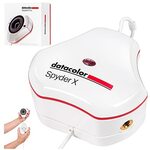Colorimeter with ambient light sensor built in. $213 ebay thats the next cheapest I could find. Used for instrumented calibration of a single monitor, telly or projector .. requires test patterns (freely available) and maybe a windows computer or a VM if using HFCR (free and recommended software) and a tripod of some sorts ti keep it steady ..plenty of guides online .. If there is a mistake in posting please delete the post.. this is a mniche product anyways
Datacolor Spyder X Pro – Monitor Calibrator $189.69 (RRP $230) Delivered @ Amazon Germany via AU
Last edited 19/11/2023 - 13:31 by 1 other user
 CamelCamelCamel.
CamelCamelCamel.Related Stores
closed Comments

Phone is a reasonably close approximation, this is a tool to get to screen vs print levels of accuracy, within the limitations of your monitor.
you are correct on the vertical integration however.To be honest if you’re just gaming / browsing you likely won’t need something like the spyderx. Look up the icc profile on your monitor support page and it too will get a decent approximation. Alternatively use this database https://tftcentral.co.uk/articles/icc-profiles-and-monitor-c…
If calibration is important to you these are great, accurate, quick and easy to use. I do a calibration before i start editing photos but that’s infrequent.

There is.
iPhone do it better because the few models with tight quality control mean the apps can calibrate for the small number of camera variations.It is impossible to properly support every Android model and even the smaller selection of flagships tend to chop and change things between markets and even batches of the same model.
For it to really matter you need a good monitor anyway, so for a professional a proper made for purpose factory calibrated non-firmware shifting device isn't a big deal.

Samsung TVs also have calibration with Samsung phones. So I think you need some vertical integration or manual testing per device/detailed specs from the manufacturer.

Calibration if done properly is likely wearing glasses for the first time.. if done incorrectly it may yield a worse performnace than an out of the box device …These days most devices come pretty well calibrated so its better to stick with the OOB experience unless you know what you are doing.. there are plenty of videos on how to calibrate using a phones sensor online ..both android and iphone ..Moreover correcting visuals to appear as they actually look or a movie to look as the director wanted it to look may not appeal to everyone …Calibration is a custom fit.. your room, your lighting, your visual output device .. Manufacturers calibrate to what is generally most liked.. You can attempt a calibration with a phone but I would suggest keeping a back up.. here is one video on you tube for example https://www.youtube.com/watch?v=jpL2nDAKuuI

I see it differently.
What’s the point of calibrating when other people don’t calibrate their monitors or view media on phones? For example if I take a photo, use my calibrated monitor to make photo corrections, then send the photo to a friend who hasn’t got a calibrated monitor. The photo will look less than ideal. Most people have their monitors on high contrast, high vibrancies and colour saturations.
I see a use if you are making photo edits for print or for professional applications. But for everyday users my opinion is the benefits are marginal and cost not justified.

I use it for calibrating display devices..my OLED and projector.. and I am everyday user not a pro photographer.. I want my devices to produce the best that they are capable of so if I invest in expensive displays I want to make sure I get the best bang for my buck.. may not work for you which is why I said not a mass product .. has a very niche market ..most people do not know their monitors have contrast and brightness ..forget about calibration

from personal experience, stick to calibrite for calibrating monitors.

why

Because most people will see a calibrated TV and say it's dull, flat etc.

Spyder colorimeters tend to be un-reproducible on monitors. You calibrate the same monitor back to back 3 times, or a different but identical model of monitor, you will get substantially different results every single time. Is that really calibration? Or it it just spitting out random values? Is it displaycal subtlely sabotaging a brand they don't like? Nobody knows, and the ~~$60 one time difference in price isn't worth my time to investigate.

I find my Spyder Elite tends to make the monitor a tad too warm after calibration. After calibration with the Calibrite I was surprised at how well matched the monitor is to my iphone 14 Pro (which meant to have excellent colour accuracy).

Going have to second that from someone that recently finally got a Calibrite coming from a Spyder Elite.

I got the colour monkey, or x-rite or whatever, and my prints still don't match my screen. I got it working just right but then the supplier of my ink stopped shipping to Australia, so I imported from the UK instead and my prints are (profanity). And with each new computer I use the way to colour manage changes again and again. I can see why pro printers can charge so much.

Invest in a printer calibrator, now that you have your monitor calibrated :)

I've used this with the fantastic open source DisplayCal https://displaycal.net/. Highly recommend over the built in software.

Yeah that’s what I use for my xrite.

From what I've read the Spyder is not considered quite as good as the Xrite by the DisplayCal creator. But it's what I have on hand, so it's what I use.

I use the iProfiler, what's the advantage here?

Anyone know one that can do HDR and doesn't cost a gorillion dollars?






I've always wondered, why isn't there a way of doing monitor colour calibration with a phone? Apple tv supports colour calibration of a tv if you have an iPhone, is this kind of thing only possible with the vertical integration that apple has which guarantees some level of calibration on the iPhone image sensor?